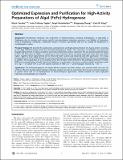Optimized Expression and Purification for High-Activity Preparations of Algal [FeFe]-Hydrogenase
Author(s)
Yacoby, Iftach; Tegler, Lotta Tollstoy; Pochekailov, Sergii; Zhang, Shuguang; King, Paul W.
DownloadYacoby-2012-Optimized Expression.pdf (508.5Kb)
PUBLISHER_POLICY
Publisher Policy
Article is made available in accordance with the publisher's policy and may be subject to US copyright law. Please refer to the publisher's site for terms of use.
Terms of use
Metadata
Show full item recordAbstract
Background:
Recombinant expression and purification of metallo-enzymes, including hydrogenases, at high-yields is challenging due to complex, and enzyme specific, post-translational maturation processes. Low fidelities of maturation result in preparations containing a significant fraction of inactive, apo-protein that are not suitable for biophysical or crystallographic studies.
Principal Findings:
We describe the construction, overexpression and high-yield purification of a fusion protein consisting of the algal [2Fe2S]-ferredoxin PetF (Fd) and [FeFe]-hydrogenase HydA1. The maturation of Fd-HydA1 was optimized through improvements in culture conditions and media components used for expression. We also demonstrated that fusion of Fd to the N-terminus of HydA1, in comparison to the C-terminus, led to increased expression levels that were 4-fold higher. Together, these improvements led to enhanced HydA1 activity and improved yield after purification. The strong binding-affinity of Fd for DEAE allowed for two-step purification by ion exchange and StrepTactin affinity chromatography. In addition, the incorporation of a TEV protease site in the Fd-HydA1 linker allowed for the proteolytic removal of Fd after DEAE step, and purification of HydA1 alone by StrepTactin. In combination, this process resulted in HydA1 purification yields of 5 mg L−1 of culture from E. coli with specific activities of 1000 U (U = 1 µmol hydrogen evolved mg−1 min−1).
Significance:
The [FeFe]-hydrogenases are highly efficient enzymes and their catalytic sites provide model structures for synthetic efforts to develop robust hydrogen activation catalysts. In order to characterize their structure-function properties in greater detail, and to use hydrogenases for biotechnological applications, reliable methods for rapid, high-yield expression and purification are required.
Date issued
2012-04Department
Massachusetts Institute of Technology. Department of Biological Engineering; Massachusetts Institute of Technology. Media Laboratory; Program in Media Arts and Sciences (Massachusetts Institute of Technology)Journal
PLoS ONE
Publisher
Public Library of Science
Citation
Yacoby, Iftach et al. “Optimized Expression and Purification for High-Activity Preparations of Algal [FeFe]-Hydrogenase.” Ed. Paul D. Riggs. PLoS ONE 7.4 (2012): e35886.
Version: Final published version
ISSN
1932-6203